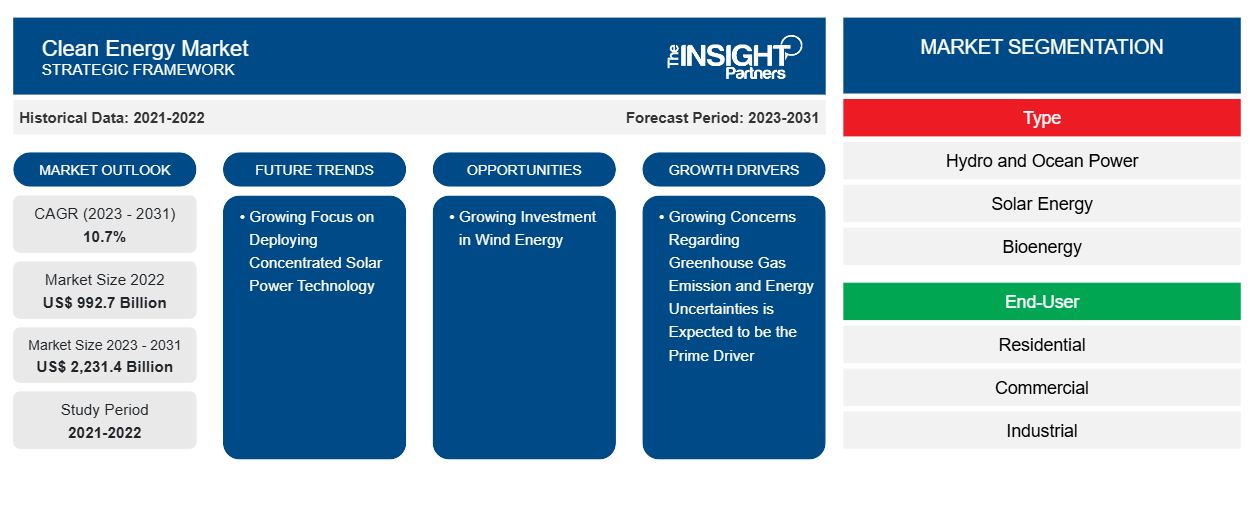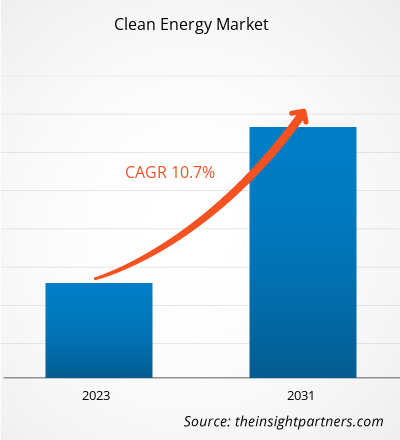The clean energy market size is projected to reach US$ 2,231.4 billion by 2031 from US$ 992.7 billion in 2022. The market is expected to register a CAGR of 10.7% during 2023–2031. Growing focus on reducing GHG emissions, increasing emphasis on renewable energy sources for promoting sustainability, and rising concern toward environment protection are likely to remain key trends in the market.
Clean Energy Market Analysis
The changing energy circumstances across the globe are creating a demand for more sustainable energy sources to meet the rising energy need. The increasing energy demand showcases the importance of clean energy sources. Rising energy prices and supply uncertainties owing to various geopolitical challenges are anticipated to propel the growth of the clean energy market during the forecast period. Clean energy utilization helps reduce the adverse environmental effects of standard energy resources such as coal and oil. Thus, governments of several countries worldwide imposed tax incentives and favorable policies to encourage the adoption of clean energy sources, which is acting as the major driving factor for the market.
Clean Energy Market Overview
With the mounting population and industrialization, the demand for energy is also rising at the global level. This has boosted the need for alternative energy sources, as traditional energy resources such as fossil fuels are directing to environmental pollution. Clean alternative options such as solar and wind curb immense carbon emissions and their negative impact on the environment and help balance the energy supply and demand. Thus, the rise in the development of the renewable energy sector and supportive government initiatives toward using a sustainable approach to reduce carbon emissions are fueling the investment in clean energy sources such as wind, solar, geothermal, and hydro.
Customize This Report To Suit Your Requirement
You will get customization on any report - free of charge - including parts of this report, or country-level analysis, Excel Data pack, as well as avail great offers and discounts for start-ups & universities
Clean Energy Market: Strategic Insights

-
Get Top Key Market Trends of this report.This FREE sample will include data analysis, ranging from market trends to estimates and forecasts.
Clean Energy Market Drivers and Opportunities
Growing Concerns Regarding Greenhouse Gas Emission and Energy Uncertainties
The advancement of the energy system following the Paris Agreement, launched in 2015 and entered into force in 2016, has stimulated the utilization of clean energy sources to lower carbon emissions. A key contributor to greenhouse gas emissions that lead to climate change is power generation by utilizing fossil fuels. The employment of clean energy sources, such as solar, wind, hydro, and geothermal, is rising due to growing concern toward more sustainable and environment-friendly energy alternatives, rising climate change concerns, and supportive government initiatives for boosting the use of clean energy across the globe. Governments of several economies are recognizing the significance of switching to clean sources to meet the future targets of achieving low to zero carbon emissions. For instance, the US government targets to lower net GHG emissions by ~50–52% compared to 2005 levels by 2030 and attain net zero emissions by 2050. Likewise, the German government has fixed a target to lower its carbon emissions by ~65% compared to 1990 levels by 2030.
Due to the mounting energy uncertainties in Europe owing to the Russia-Ukraine war, governments of several countries identified the capability of domestically generated clean energies. The clean energy market includes power sources, primarily wind, hydroelectric, geothermal, and solar. Thus, the growing concerns regarding greenhouse gas emissions and energy uncertainties are acting as major drivers for the clean energy market.
Growing Investment in Wind Energy to Establish Alternative Energy Sources
Wind energy, which primarily helps in meeting rising energy demand in an environment-friendly way, is emerging as an important alternative to fossil fuels. Further, governments of various nations are focusing on investing in onshore and offshore wind projects to reduce the dependence on fossil fuels to mitigate carbon emissions and their toxic impacts on the environment. Offshore wind projects are perceived to be more efficient than onshore wind farms owing to greater consistency, higher wind speeds, and a lack of physical interference from land. The increasing number of offshore wind projects is also acting as a major boosting factor for the growth of the clean energy market globally.
Clean Energy Market Report Segmentation Analysis
The key segments that contributed to the derivation of the clean energy market analysis are type and end user.
- Based on type, the clean energy market has been divided into hydro and ocean power, solar energy, bioenergy, geothermal energy, and wind energy. The hydro and ocean power segment held the largest market share in 2023.
- By end user, the market has been segmented into residential, commercial, and industrial. The residential segment dominated the market in 2023.
Clean Energy Market Share Analysis by Geography
The geographic scope of the clean energy market report is mainly divided into five regions: North America, Europe, Asia Pacific, the Middle East & Africa, and South & Central America.
Asia Pacific dominated the clean energy market in 2023. The growing population and increasing energy demand are acting as a major driving factor for the clean energy market in Asia Pacific. Additionally, growing government focus on initiating supportive measures and policies to reduce the dependence on fossil fuels and reduce carbon emissions will most likely drive the clean energy market in the region. Growing environmental pollution and harsh climate change impacts are major concerns that are stimulating the requirement for clean alternative energy sources to reduce the utilization of fossil fuels. For instance, the Indian Renewable Energy Development Agency offers low-interest loans for developing eligible renewable energy projects in the country. India has targeted achieving 50% cumulative electric power installed by 2030 from renewables and net-zero carbon emissions by 2070. Moreover, in 2022, the government introduced a "Mission 500GW" action plan to attain the overall renewable target.
Clean Energy Market Regional Insights
The regional trends and factors influencing the Clean Energy Market throughout the forecast period have been thoroughly explained by the analysts at The Insight Partners. This section also discusses Clean Energy Market segments and geography across North America, Europe, Asia Pacific, Middle East and Africa, and South and Central America.
Clean Energy Market Report Scope
| Report Attribute | Details |
|---|---|
| Market size in 2022 | US$ 992.7 Billion |
| Market Size by 2031 | US$ 2,231.4 Billion |
| Global CAGR (2023 - 2031) | 10.7% |
| Historical Data | 2021-2022 |
| Forecast period | 2023-2031 |
| Segments Covered |
By Type
|
| Regions and Countries Covered |
North America
|
| Market leaders and key company profiles |
|
Clean Energy Market Players Density: Understanding Its Impact on Business Dynamics
The Clean Energy Market is growing rapidly, driven by increasing end-user demand due to factors such as evolving consumer preferences, technological advancements, and greater awareness of the product's benefits. As demand rises, businesses are expanding their offerings, innovating to meet consumer needs, and capitalizing on emerging trends, which further fuels market growth.

- Get the Clean Energy Market top key players overview
Clean Energy Market News and Recent Developments
The clean energy market is evaluated by gathering qualitative and quantitative data post primary and secondary research, which includes important corporate publications, association data, and databases. A few of the developments in the clean energy market are listed below:
- Canadian Solar Inc. declared that Yangzhou City's municipal government in Jiangsu Province, China, signed a multi-year investment agreement with its majority-owned subsidiary, CSI Solar Co Ltd. According to the agreement, CSI Solar plans to expand Yangzhou's clean energy manufacturing industrial park's capacity for manufacturing vertically integrated high-efficiency wafers, cells, and modules, as well as battery systems. (Source: Press Release/Company Website/Newsletter, January 2023)
- Composites, Inc. (TPI) (Nasdaq: TPIC), a global company emphasizing innovative and sustainable solutions, announced that it has renewed its supply agreements with GE Renewable Energy through 2025. GE and TPI also strategize to work together on GE's next-generation blade types, including the possibility of totaling more production lines in 2023 in addition to the nine production lines GE has in operation with TPI. (Source: Press Release/Company Website/Newsletter, January 2023)
Clean Energy Market Report Coverage and Deliverables
The "Clean Energy Market Size and Forecast (2021–2031)" report provides a detailed analysis of the market covering below areas:
- Clean energy market size and forecast at global, regional, and country levels for all the key market segments covered under the scope
- Clean energy market trends as well as market dynamics such as drivers, restraints, and key opportunities
- Detailed PEST/Porter’s Five Forces and SWOT analysis
- Clean energy market analysis covering key market trends, global and regional framework, major players, regulations, and recent market developments
- Industry landscape and competition analysis covering market concentration, heat map analysis, prominent players, and recent developments for the clean energy market
- Detailed company profiles
- Historical Analysis (2 Years), Base Year, Forecast (7 Years) with CAGR
- PEST and SWOT Analysis
- Market Size Value / Volume - Global, Regional, Country
- Industry and Competitive Landscape
- Excel Dataset
Recent Reports
Testimonials
Reason to Buy
- Informed Decision-Making
- Understanding Market Dynamics
- Competitive Analysis
- Identifying Emerging Markets
- Customer Insights
- Market Forecasts
- Risk Mitigation
- Boosting Operational Efficiency
- Strategic Planning
- Investment Justification
- Tracking Industry Innovations
- Aligning with Regulatory Trends





















 Get Free Sample For
Get Free Sample For